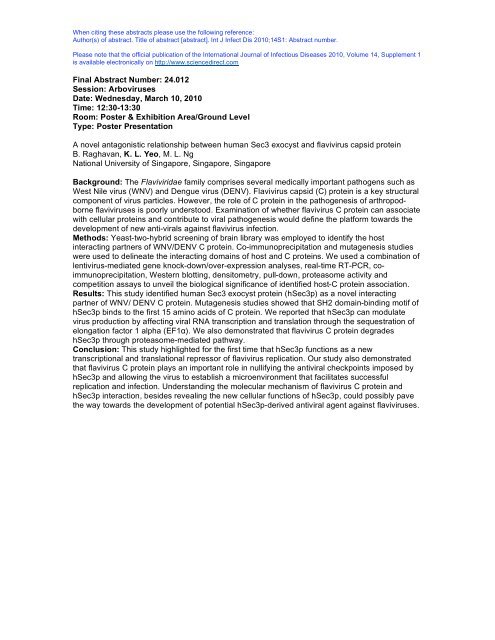14th ICID - Poster Abstracts - International Society for Infectious ...
14th ICID - Poster Abstracts - International Society for Infectious ...
14th ICID - Poster Abstracts - International Society for Infectious ...
You also want an ePaper? Increase the reach of your titles
YUMPU automatically turns print PDFs into web optimized ePapers that Google loves.
When citing these abstracts please use the following reference:<br />
Author(s) of abstract. Title of abstract [abstract]. Int J Infect Dis 2010;14S1: Abstract number.<br />
Please note that the official publication of the <strong>International</strong> Journal of <strong>Infectious</strong> Diseases 2010, Volume 14, Supplement 1<br />
is available electronically on http://www.sciencedirect.com<br />
Final Abstract Number: 24.012<br />
Session: Arboviruses<br />
Date: Wednesday, March 10, 2010<br />
Time: 12:30-13:30<br />
Room: <strong>Poster</strong> & Exhibition Area/Ground Level<br />
Type: <strong>Poster</strong> Presentation<br />
A novel antagonistic relationship between human Sec3 exocyst and flavivirus capsid protein<br />
B. Raghavan, K. L. Yeo, M. L. Ng<br />
National University of Singapore, Singapore, Singapore<br />
Background: The Flaviviridae family comprises several medically important pathogens such as<br />
West Nile virus (WNV) and Dengue virus (DENV). Flavivirus capsid (C) protein is a key structural<br />
component of virus particles. However, the role of C protein in the pathogenesis of arthropodborne<br />
flaviviruses is poorly understood. Examination of whether flavivirus C protein can associate<br />
with cellular proteins and contribute to viral pathogenesis would define the plat<strong>for</strong>m towards the<br />
development of new anti-virals against flavivirus infection.<br />
Methods: Yeast-two-hybrid screening of brain library was employed to identify the host<br />
interacting partners of WNV/DENV C protein. Co-immunoprecipitation and mutagenesis studies<br />
were used to delineate the interacting domains of host and C proteins. We used a combination of<br />
lentivirus-mediated gene knock-down/over-expression analyses, real-time RT-PCR, coimmunoprecipitation,<br />
Western blotting, densitometry, pull-down, proteasome activity and<br />
competition assays to unveil the biological significance of identified host-C protein association.<br />
Results: This study identified human Sec3 exocyst protein (hSec3p) as a novel interacting<br />
partner of WNV/ DENV C protein. Mutagenesis studies showed that SH2 domain-binding motif of<br />
hSec3p binds to the first 15 amino acids of C protein. We reported that hSec3p can modulate<br />
virus production by affecting viral RNA transcription and translation through the sequestration of<br />
elongation factor 1 alpha (EF1). We also demonstrated that flavivirus C protein degrades<br />
hSec3p through proteasome-mediated pathway.<br />
Conclusion: This study highlighted <strong>for</strong> the first time that hSec3p functions as a new<br />
transcriptional and translational repressor of flavivirus replication. Our study also demonstrated<br />
that flavivirus C protein plays an important role in nullifying the antiviral checkpoints imposed by<br />
hSec3p and allowing the virus to establish a microenvironment that facilitates successful<br />
replication and infection. Understanding the molecular mechanism of flavivirus C protein and<br />
hSec3p interaction, besides revealing the new cellular functions of hSec3p, could possibly pave<br />
the way towards the development of potential hSec3p-derived antiviral agent against flaviviruses.
















